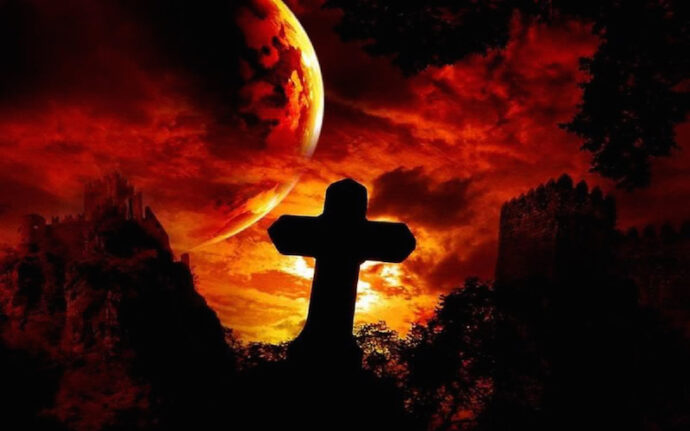As I was driving to see Four Blood Moons, a new docu-drama about Biblical prophecy, an enormous storm blew in. During the film, long rumbles of thunder interrupted interviews about prophets, lunar cycles, and civilizational war. Lightning flickered in the west as we left.
It’s awfully tempting to read omens into natural phenomena, isn’t it? Picture it: you’re sitting in a suburban Raleigh cinema, watching a wall-sized projection of a Texas mega-pastor intoning the details of apocalyptic prophecies, and then actual thunder roars. And you can’t help it. You start to wonder. Is it a sign?
John Hagee has a penchant for seeing such signs. The popular San Antonio pastor is the founder of Christians United for Israel, an organization that makes AIPAC look wishy-washy, and the author of the book Four Blood Moons, which he’s now turned into a docu-drama of the same name.
Ostensibly, FBM is about biblical prophecy, the contemporary Middle East, and the role of Jews in history, though it’d be more accurate to say that FBM is an attempt to use history and science to prove the existence of a Christian, pro-American God.
During the eclipse of a full moon, the face of the disk turns red: a blood moon. The appearance of four blood moons in a short period of time is called a tetrad. Right now, we’re three-quarters of the way through a tetrad in which each blood moon falls on a Jewish holiday—Passover 2014, Sukkot 2014, Passover 2015, and (appearing in skies near you this September!) Sukkot 2015.
Blood moons happen frequently. And the coincidence of blood moons and Jewish holidays is fairly commonplace, which, it turns out, isn’t such a coincidence after all since Passover and Sukkot always begin on the full moon—as does Purim.
Still, tetrads that fall entirely on Jewish holidays aren’t common, and quite a few have taken place during significant moments in Jewish history—in 1492-1493, in the midst of the Spanish Inquisition; in 1949-1950, shortly after Israel became a state; and in 1967-1968, the time of the Six-Day War in Israel.
At this point, you may be getting those Ouija-board-chills, or perhaps even sensing the whiff of the occult. These creepy coincidences can work all so well, in fact, that Hagee himself is sensitive to the possibility that he’s dabbling in witchcraft. So, in a neat bit of circular logic, Hagee explains that the blood moon prophecy isn’t witchery.
“Astrology,” he says, “is a false science” and a form witchcraft, while “astronomy is a true science.” What makes this particular prophecy astronomical, not astrological? As far as I can tell, it’s mostly that Hagee believes it’s true.
Plus, it’s in the Bible. “Before the great and the terrible days of the Lord come…The sun shall turn into darkness, and the moon into blood,” the prophet Joel explains. The book of Acts, in the New Testament, restates the point, and in Revelation the moon becomes “as red as blood.”
Blood, warfare, and Nostradamus-style speculation make for good entertainment, and Hagee’s book reportedly had a print run of 750,000. For the film, he enlisted award-winning filmmaker Keith Miller as director. Producer Rick Eldridge told RD that “three private entities” had funded the project, but he declined to name them. Originally conceived as a one-night-only screening in hundreds of theaters nationwide, FBM had a second round of showings this past Thursday night. At the Raleigh theater I went to, around seventy people showed up. A theater employee said that the original showing, on two screens, had been sold out.
After a short, science-y introduction to the mechanics of the lunar eclipse, FBM dives into dramatized depictions of Jews in peril, getting rescued by God. There are scenes from Inquisition Spain, and from Israel in the 1940s and 1960s.
Along the way, a cast of male* experts, which includes (the recently incarcerated) Dinesh D’Souza, a pair of rabbis, and Dennis Prager, explains exactly how improbable the survival of the Jewish people would be without divine intervention—which tends to happen in conjunction with blood moons.
The whole enterprise builds toward the obvious question: what will happen to the Jews this time around? Regarding the answer, FBM does not hedge: it’s marauding Muslim hordes. Throughout the film, it’s Muslims—swarthy, disorganized, kaffiyeh-clad troops—who antagonize the Jews in most dramatic reenactments. And it’s Muslims—ISIS, and especially Iran—whom the film’s experts suggest will be the wicked actors in this next blood moon drama. A brief section citing the shared Abrahamic heritage of Jews and Christians entirely omits Islam, the third Abrahamic faith.
At its core, though, FBM is not really concerned with Islam or Iran. In fact, it’s not really all that concerned with Jews, either. FBM is a religious proof text for Christianity—a cultural product that offers concrete, science-y, academic evidence that men like John Hagee are totally right about everything.
Again and again, FBM harnesses Jewish history and astronomy to provide evidence for God amidst contemporary upheaval. As such, it’s tailored to a small, fearful sliver of the diverse evangelical scene; it’s a movie intended to tell its viewers that the world, unto and including the very movement of the earth and the moon, conforms to their beliefs.
Problem is, blood moons are highly predictable events—the product of celestial clockwork. For the lunar eclipse to be a prophetic player, either God has to push history to conform to the fixed pattern of the moon, or the moon must somehow alter its course for history in a way that astronomers haven’t yet noticed.
Neither idea is especially appealing, logically or theologically. But for Hagee that isn’t cause for concern. Science sounds authoritative; astronomy is science; therefore astronomical events have authority. QED.
FBM treats Jews in much the same way that it treats the moon: as something distant, abstract, and faintly inscrutable, that can be used to confirm a fragile thesis. It takes a rather determined theology, or a selective lens, to see Jewish history as a straightforward, triumphant story of divine care, but Hagee does his best.
Not all Jews will appreciate being conscripted into an evangelical drama, even in the role of the hero. I’ve made this point before, but it’s worth repeating: philo-Semitism and anti-Semitism can look awfully similar. Both treat Jews as potent historical symbols, while neither seems to pay much attention to how Jews themselves interpret their own history. And both are notoriously tone deaf when it comes to appreciating the diversity of actual Jewish people.
FBM also happens to be tone deaf in a fairly literal sense: the actors in the dramatic reenactments handle Hebrew as if it were some guttural annex of Midwestern English. Hagee, who leads trips to Israel and has made a career out of Jewish-Christian relations, still can’t pronounce the word Sukkot (the second syllable rhymes with coat, not with cot).
But this isn’t a film about Israel as an actual place. It’s a film about Israel as an idea. In fact, geographical details cause Hagee some problems, since lunar eclipses aren’t visible worldwide; this particular tetrad doesn’t appear in Israeli skies at all, which may actually be a perfect metaphor for Hagee’s project.
During the taped panel discussion that forms a coda to the film, a panelist points this out, and the pastor squirms. The panel moderator jumps in: “Is it because of our role as friend and defender of Israel?” Hagee ignores the lifeline. For those who seek prophecy, some natural phenomena (thunderstorms, eclipses) may just be too dramatic to ignore, even when the details don’t quite work out. “I don’t have an answer for why Israel can’t see it,” Hagee admits. They move on.
* In fact, the only woman who speaks during the entire documentary is a character in the Inquisition reenactment. She spends most of the time crying as inquisitors torture her heroic husband.





